Fort Benning
| Fort Benning | |
|---|---|
| Part of Training and Doctrine Command (TRADOC) Forces Command (FORSCOM) Special Operations Command (USSOCOM) | |
| Columbus, Georgia Metropolitan Statistical Area Chattahoochee County, Georgia (93%) and Russell County, Alabama (7%) ≈182,000 acres (74,000 ha, 284 sq mi, 740 km2) | |
 Maneuver Center of Excellence | |
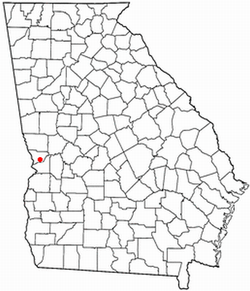 | |
 Fort Benning | |
| Coordinates | 32°21′58″N 84°58′09″W / 32.36611°N 84.96917°WCoordinates: 32°21′58″N 84°58′09″W / 32.36611°N 84.96917°W |
| Type | Army post |
| Site information | |
| Controlled by | |
| Website | Official Website |
| Site history | |
| Built | 1909 |
| In use | 1918–present |
| Garrison information | |
| Garrison | Units and tenant units
|
Fort Benning is a United States Army post straddling the Alabama–Georgia border next to Columbus, Georgia. Fort Benning supports more than 120,000 active-duty military, family members, reserve component soldiers, retirees and civilian employees on a daily basis. It is a power projection platform, and possesses the capability to deploy combat-ready forces by air, rail, and highway. Fort Benning is the home of the United States Army Maneuver Center of Excellence, the United States Army Armor School, United States Army Infantry School, the Western Hemisphere Institute for Security Cooperation (formerly known as the School of the Americas), elements of the 75th Ranger Regiment, the 1st Security Force Assistance Brigade, and other tenant units.
It is named after Henry L. Benning, a brigadier general in the Confederate States Army during the Civil War.[1][2] Fort Benning is one of ten U.S. Army installations named for former Confederate Generals.[3]
Since 1909, Fort Benning has served as the Home of the Infantry. Since 2005, Fort Benning has been transformed into the Maneuver Center of Excellence, as a result of the 2005 Base Realignment and Closure (BRAC) Commission's decision to consolidate a number of schools and installations to create various "centers of excellence". Included in this transformation was the move of the Armor School from Fort Knox to Fort Benning.[4]
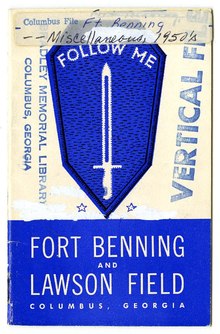
History[]
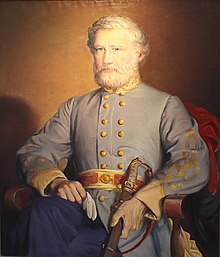
Camp Benning was established October 19, 1918,[5] initially providing basic training for World War I units, post-war. Dwight D. Eisenhower served at Benning from December 24, 1918,[6] until March 15, 1919,[7] with about 250 of his Camp Colt, Pennsylvania, tankers who transferred to Benning after the armistice.[8]:72 On December 26, 1918, a portion of the Camp Polk (near Raleigh, North Carolina) tank school was transferred to Camp Benning "to work in conjunction with the Infantry school".[9] Camp Benning tank troops were moved to Camp Meade from February 19–21, 1919.[9]
In February 1920, Congress voted to declare Camp Benning a permanent military post and appropriated more than $1 million of additional building funds for the Infantry School of Arms, which later became the Infantry School.[10] By the fall of 1920, more than 350 officers, 7,000 troops and 650 student officers lived at Camp Benning.[10] The post was renamed to Fort Benning in 1922, after Henry L. Benning, a general in the army of the Confederate States of America.[1][11] Benning fought against U.S. Army troops in the Civil War as commander of Confederate States Army forces. [12][13] In 1924, Brig. Gen. Briant H. Wells became the fourth commandant of the Infantry School and established the Wells Plan for permanent construction on the installation, emphasizing the importance of the outdoor environment and recreation opportunities for military personnel. During Wells' tenure, the post developed recreational facilities such as Doughboy Stadium, Gowdy Field, the post theater and Russ swimming pool. Doughboy Stadium was erected as a memorial by soldiers to their fallen comrades of World War I. One of the Doughboys' original coaches was a young captain named Dwight D. Eisenhower.[14][15][16]
Lt. Col George C. Marshall was appointed assistant commandant of the post in 1927 and initiated major changes. Marshall, who later became the Army Chief of Staff during World War II, was appalled by the high casualties of World War I caused, he thought, by insufficient training. He was determined to prevent a lack of preparation from costing more lives in future conflicts. He and his subordinates revamped the education system at Fort Benning. The changes he fostered are still known as the Benning Revolution. Later in his life, Marshall went on to author the Marshall Plan for reviving postwar Europe and was awarded the Nobel Peace Prize in 1953.[16]
In August, 1940, 2 officers and 46 enlisted volunteers of what was known as the Parachute Test Platoon, after intensive training, made their first airborne jump over Lawson Field at Fort Benning. Observers from several countries including Germany and the Soviet Union attended. These 48 were the seed that grew into the branches of America's Airborne Infantry.

During World War II Fort Benning had 197,159 acres (797.87 km²) with billeting space for 3,970 officers and 94,873 enlisted persons. Among many other units, Fort Benning was the home of the 555th Parachute Infantry Battalion, whose training began in December 1943. The unit's formation was an important milestone for black Americans, as was explored in the first narrative history of the installation, Home of the Infantry.[17][18] The battalion, later expanded to become the 555th Parachute Infantry Battalion, was trained at Fort Benning but did not deploy overseas and never saw combat during World War II. During this period, the specialized duties of the Triple Nickel were primarily in a firefighting role, with over one thousand parachute jumps as smoke jumpers. The 555th was deployed to the Pacific Northwest of the United States in response to the concern that forest fires were being set by the Japanese military using long-range incendiary balloons. The 82nd Armored Reconnaissance Battalion was activated July 15, 1940, and trained at the Fort.[19][20][21][22] The 17th Armored Engineer Battalion became active and started training July 15, 1940.[23]

At the start of the Korean War an Airborne Ranger Training Center was established by John G. Van Houten under the direction of J. Lawton Collins.[24]
The 4th Infantry Division, first of four divisions committed by the United States to the North Atlantic Treaty Organization, reorganized and completed its basic training at Fort Benning (Sand Hill and Harmony Church areas) from October 1950 to May 1951, when it deployed to Germany for five years.
The Airborne School on Main Post has three 249-foot (76 m) drop towers called "Free Towers." They are used to train paratroopers. The towers were modeled after the parachute towers at the 1939 World's Fair in New York. Only three towers stand today; the fourth tower was toppled by a tornado on March 14, 1954.
During the spring of 1962 General Herbert B. Powell, Commanding General, U.S. Continental Army Command, directed that all instruction at the Infantry School after July 1 reflect Reorganization Objective Army Division structures.[25] Therefore, the Infantry School asked for permission to reorganize the 1st Infantry Brigade under a ROAD structure. Instead, the Army Staff decided to inactivate the Pentomic-structured brigade and replace it with a new ROAD unit, the 197th Infantry Brigade, which resolved a unit designation issue. With the designation 1st Infantry Brigade slated to return to the 1st Infantry Division when it converted to ROAD, the existing unit at Fort Benning required a new title. The staff selected an infantry brigade number that had been associated with an Organized Reserve division that was no longer in the force. For the new ROAD brigade at Fort Benning, Georgia, the adjutant general on August 1, 1962, restored elements of the 99th Reconnaissance Troop, which thirty years earlier had been organized by consolidating infantry brigade headquarters and headquarters companies of the 99th Infantry Division, as Headquarters and Headquarters Companies, 197th and 198th Infantry Brigades.
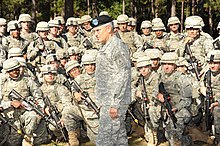
Fort Benning was the site of the Scout dog school of the United States during the Vietnam War, where the dogs trained to detect ambushes in enemy terrain got their initial training, before being transferred to Vietnam for further advanced courses.[26]
Fort Benning also had an urban village, McKenna Military Operations in Urban Terrain, built by Army engineers for urban training of soldiers. It was used for live, virtual and constructive experimentation on soldier systems, weapons, and equipment. The site was approximately 200 meters square, and included 15 buildings resembling a European village. There was a church, small houses, domestic residences and office-style buildings.[27]
In 1984, following the signing of the Panama Canal Treaty, the School of the Americas relocated from Fort Gulick (Panama) to Fort Benning.[28] After criticism concerning human rights violations committed by a number of graduates in Latin America, the school was renamed Western Hemisphere Institute for Security Cooperation.[29]
As a result of national protests following the May 25, 2020, murder of George Floyd, an African American man, by Minneapolis police, Congress began to evaluate Democratic proposals to strip the names of Confederate leaders from military bases, including Fort Benning.[30]
Commanding Generals[]

Post information[]
There are four main cantonment areas on Fort Benning: Main Post, Kelley Hill, Sand Hill, and Harmony Church.
Main Post[]
Main Post houses various garrison and smaller FORSCOM units of Fort Benning such as 14th Combat Support Hospital and 11th Engineer Battalion FORSCOM as well as a number of TRADOC-related tenants, e.g. the Officer Candidate School, the Non-Commissioned Officers Academy, and the Airborne School. McGinnis-Wickham Hall (formerly known as Infantry Hall) is the post headquarters and Maneuver Center of Excellence. Adjacent is the Ranger Memorial and the National Infantry Museum. The Army Infantry School conducts its graduations on Inouye Field, sprinkled with soil from the battlegrounds of Yorktown, Antietam, Soissons, Normandy, Corregidor, Korea, Vietnam, Iraq, and Afghanistan.[32]
Kelley Hill[]
The 197th Infantry Brigade was located on Kelley Hill in the 1970s and early 1980s
Kelley Hill formerly housed the 3d Brigade Combat Team of the 3d Infantry Division (Mechanized), the parent unit of two combined armed battalions; 1st Battalion, 15th Infantry Regiment, 2d Battalion, 69th Armor Regiment, as well as 3d Squadron, 1st Cavalry Regiment, 1st Battalion, 10th Field Artillery Regiment, and two support battalions; the 203d Brigade Support Battalion and the Special Troops Battalion, 3d BCT. Included in the roster was the 179th Military Intelligence Detachment.
Between December 11, 2015, and December 15, 2015, the 3d BCT's six subordinate battalions performed inactivation ceremonies on Sledgehammer Field. On December 16, 2015, 1st Battalion, 28th Infantry Regiment Task Force (or Task Force 1-28) was activated in its place. Task Force 1-28 is a 1053-member unit "made up of selected soldiers from the six inactivated battalions that formed the 3d Brigade Combat Team, 3rd Infantry Division".[33]
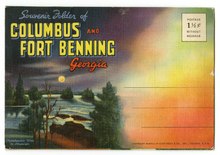
Sand Hill[]
Sand Hill is the primary location of the 198th Infantry Brigade and 197th Infantry Brigade responsible for training Infantry One Station Unit Training (OSUT). Its units include the following:
- 1st Battalion, 19th Infantry Regiment
- 2d Battalion, 19th Infantry Regiment
- 2d Battalion, 29th Infantry Regiment
- 1st Battalion, 46th Infantry Regiment
- 2d Battalion, 47th Infantry Regiment
- 3d Battalion, 47th Infantry Regiment
- 1st Battalion, 50th Infantry Regiment
- 2d Battalion, 54th Infantry Regiment
- 2d Battalion, 58th Infantry Regiment
- 30th AG Battalion (Reception)

Harmony Church[]
Harmony Church area houses the 194th Armored Brigade, 316th Cavalry Brigade Armor School and the first phase of Ranger School, 4th Ranger Training Battalion (ARTB). After the 2005 Base Realignment and Closure (BRAC) Commission's decision to create the Maneuver Center of Excellence (MCoE), Harmony Church is now the new home of the Armor School.
Command group[]

Current Command[34]
- Commanding General, U.S. Army MCoE: Major General Patrick J. Donahoe[35]
- Command Sergeant Major, U.S. Army MCoE: Command Sergeant Major Derrick C. Garner[36]
- Deputy to the Commanding General, U.S. Army MCoE: Mr. Donald M. Sando[37]
- Commandant, U.S. Army Infantry School: Major General David M. Hodne
- Command Sergeant Major, U.S. Army Infantry School: Command Sergeant Major Christopher E. Gunn
- Commandant, U.S. Army Armor School: Brigadier General Kevin D. Admiral
- Command Sergeant Major, U.S. Army Armor School: Command Sergeant Major Tony T. Towns
- Deputy Commanding General, U.S. Army MCoE: Brigadier General Charles G. Kemper IV
- Chief of Staff, U.S. Army MCoE: Colonel Christopher Budihas[38]
- Garrison Commander, U.S. Army MCoE: Colonel Matthew Scalia[39]
- Garrison Command Sergeant Major, U.S. Army MCoE: Command Sergeant Major Brett W. Johnson[40]
Units and tenant units[]

Armor School move[]
Fort Benning was selected by the Base Realignment and Closing Commission to be the home of the new Maneuver Center of Excellence (MCoE). This realignment co-located the United States Army Armor Center and School,[42] formerly located at Fort Knox, Kentucky, with the Infantry Center and School.[43] This transformation was completed September 2011.[44]
See also[]
References[]
- ^ Jump up to: a b Rhea, Gordon (January 25, 2011). "Why Non-Slaveholding Southerners Fought". Civil War Trust. Civil War Trust. Archived from the original on March 21, 2011. Retrieved March 21, 2011.
- ^ Benning, Henry L. (February 18, 1861). "Speech of Henry Benning to the Virginia Convention". Proceedings of the Virginia State Convention of 1861. pp. 62–75. Retrieved March 17, 2015.
- ^ Levenson, Michael (June 11, 2020). "These Are the 10 U.S. Army Installations Named for Confederates". New York Times. Retrieved June 14, 2020.
- ^ "Maneuver Center of Excellence".[permanent dead link]
- ^ "The Founding of Camp Benning" (PDF). U.S. Army Fort Benning and The Fort Benning Maneuver Center of Excellence. US Army. Retrieved June 5, 2020.
- ^ "Dwight D. Eisenhower | Early Life and Career | October 14, 1890 - January 20, 1953". Archived from the original on June 1, 2011. Retrieved 2012-09-21.
- ^ "Eisenhower General Information". ibiblio.org.
- ^ Perret, Geoffrey (June 2000). Eisenhower (Google Books). ISBN 9781580624312. Retrieved January 21, 2011.
- ^ Jump up to: a b Rockenbach, Samuel D (October 13, 1919). Report of the Director of the Tank Corps for the year ending June 30, 1919. Congressional serial set, Issue 7688 (Report). Retrieved January 17, 2011.
- ^ Jump up to: a b Kane, Sharyn (May 2003). Fort Benning: The Land and the People. p. 172.
- ^ Benning, Henry L. (July 1, 1849). "Letter from Henry Benning to Howell Cobb". Civil War Causes. Retrieved March 17, 2015.
- ^ Petraeus, David (June 9, 2020). "Take the Confederate Names Off Our Army Bases". The Atlantic.
- ^ "Historian explores how Civil War Northerners reconciled treason with leniency | Penn State University". news.psu.edu.
- ^ Ninke, Joshua. "Doughboys to honor veterans at Doughboy Stadium". Retrieved September 3, 2013.
- ^ "Fort Benning Historic Trail". Doughboy Stadium. Archived from the original on March 20, 2013. Retrieved September 3, 2013.
- ^ Jump up to: a b Kane, Sharyn (May 2003). Fort Benning: The Land and the People. pp. 173–174.
- ^ Bunn, Michael J. (Summer 2008). "Home of the Infantry: The History of Fort Benning". Georgia Historical Quarterly. 92 (2): 268–270. ISSN 0016-8297.
- ^ Stelpflug, Peggy A.; Richard Hyatt (2007). Home of the Infantry: The History of Fort Benning. Macon: Mercer University Press. pp. 300–67. ISBN 978-0-88146-087-2.
- ^ "82nd Recon History". www.2ndarmoredhellonwheels.com. Retrieved June 13, 2020.
- ^ "After action report 82nd Armored Recon Battalion, 2nd Armored Division, June 44 thru May 45". cdmhost.com.
- ^ "World War II unit histories & officers". unithistories.com.
- ^ "History of the 2nd Armored Division - Hell On Wheels". www.militaryvetshop.com.
- ^ "cgsc.edu American Armored Divisions 1941–1945" (PDF). Archived from the original (PDF) on July 27, 2014. Retrieved July 22, 2014.
- ^ "Major General John G. Van Houten". www.soc.mil. Retrieved February 3, 2020.
- ^ Maneuver and Firepower, Chapter 11
- ^ Rubinstein, Wain (June 1969). "Enemy's Worst Enemy..." Danger Forward. Archived from the original on August 3, 2009. Retrieved June 17, 2009.
- ^ MetaVR. "MetaVR Virtual Fort Benning, McKenna Urban Operations Training Site". www.metavr.com. Archived from the original on March 1, 2019. Retrieved August 28, 2018.
- ^ McCoy, Katherine E. (2005). "Trained to Torture? The Human Rights Effects of Military Training at the School of the Americas". Latin American Perspectives. 32 (6): 47–64. doi:10.1177/0094582x05281113. S2CID 144445783.
- ^ Bill Wallace; Jim Houston (July 13, 2002). "Bay Area protesters sentenced in Georgia". San Francisco Chronicle. Retrieved August 12, 2012.
- ^ O’Brien, Connor. "Scrubbing Confederate names from Army bases gains steam in Congress, but fight with Trump looms". POLITICO. Retrieved June 13, 2020.
- ^ Maneuver Center Of Excellence Hall of Portraits, Fort Benning, GA
- ^ Milzarski, Eric (December 27, 2017). "The soil new infantrymen walk on is bloodied from every American war". We Are The Mighty.
- ^ Wright, Ben (December 15, 2015). "1st Battalion, 28th Infantry Regiment Task Force activated". Columbus Ledger-Enquirer. Retrieved February 3, 2017.
- ^ "Leaders". www.benning.army.mil.
- ^ "Major General Gary M. Brito". www.benning.army.mil.
- ^ "Command Sergeant Major Martin S. Celestine". www.benning.army.mil.
- ^ "Mr. Donald M. Sando". www.benning.army.mil.
- ^ "Colonel Andrew Cole Jr". www.benning.army.mil.
- ^ "Colonel Matthew Scalia". www.benning.army.mil.
- ^ "CSM Connie L Rounds". www.benning.army.mil.
- ^ "Pathfinder". Archived from the original on October 17, 2012.
- ^ Maureen Rose (June 13, 2011). "Final units depart Fort Knox Armor School". army.mil.
- ^ Vince Little, The Bayonet (October 22, 2009). "Activation ceremony formally links Infantry, Armor under new command at Fort Benning". army.mil.
- ^ "Fort Benning and the Valley – Home – Welcome to the Chattahoochee Valley" (PDF). fortbenningandthevalley.com.
External links[]
- Buildings and structures in Chattahoochee County, Georgia
- Columbus, Georgia
- Buildings and structures in Muscogee County, Georgia
- Buildings and structures in Russell County, Alabama
- United States Army posts
- Training installations of the United States Army
- Forts in Georgia (U.S. state)
- Columbus metropolitan area, Georgia
- Civilian Conservation Corps in Georgia (U.S. state)
- Civilian Conservation Corps in Alabama
- Populated places in Muscogee County, Georgia
- Georgia populated places on the Chattahoochee River
- Military installations established in 1909
- 1909 establishments in Georgia (U.S. state)
- Military installations in Georgia (U.S. state)






